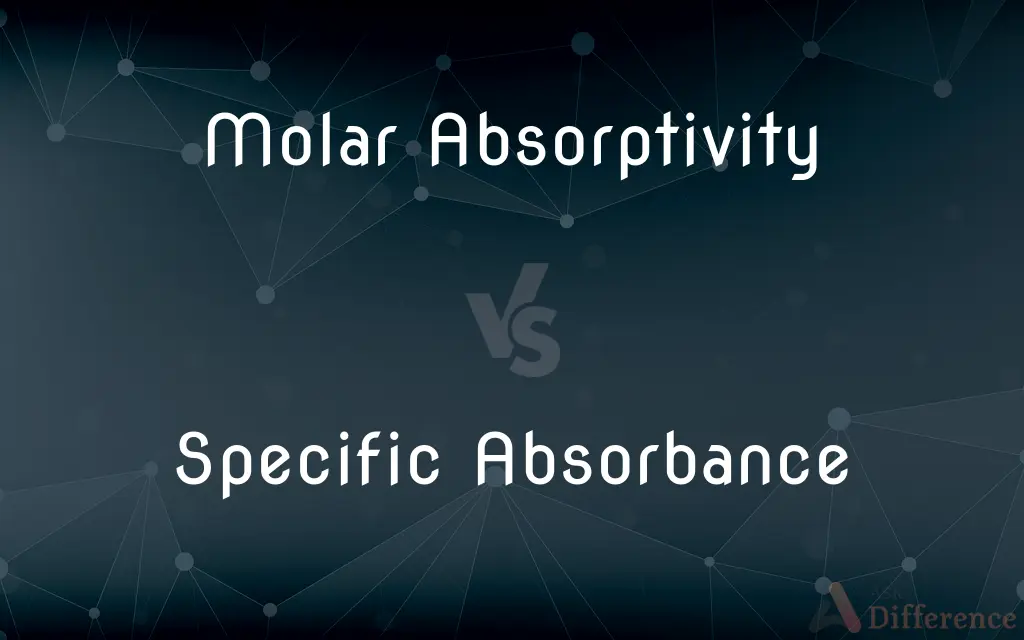Molar Absorptivity vs. Specific Absorbance — What's the Difference?
By Urooj Arif & Fiza Rafique — Published on March 4, 2024
Molar absorptivity, measure how well a substance absorbs light at a given wavelength, is intrinsic to the substance. Specific absorbance, is the absorbance of a solution per unit concentration, typically per gram per liter, under specific conditions.

Difference Between Molar Absorptivity and Specific Absorbance
Table of Contents
ADVERTISEMENT
Key Differences
Molar absorptivity (also known as the molar extinction coefficient) and specific absorbance are both critical parameters in spectrophotometry, a technique used to measure how much a chemical substance absorbs light. These terms are essential in understanding the quantitative aspects of substances in solution and their interaction with light.
Molar absorptivity, denoted by ε, is a fundamental property of a substance that quantifies the absorbance of light per molar concentration of the absorber in solution at a particular wavelength. It is expressed in units of L mol^-1 cm^-1. This coefficient is crucial in Beer-Lambert's law, which relates the intensity of light absorbed by a substance in solution to its concentration. The value of ε depends on the nature of the substance and the wavelength of the light. High molar absorptivity indicates that a substance is a strong absorber of light at the specified wavelength.
Specific absorbance, on the other hand, is a measure that relates to the absorbance of a solution at a specified wavelength per unit concentration, but it is often defined in terms of mass concentration rather than molar concentration, with typical units being L g^-1 cm^-1. It is used to describe the absorbing power of a substance without directly referencing the number of moles.
While molar absorptivity is an intrinsic property of a substance, specific absorbance can vary depending on the specific conditions under which it is measured, including the solvent used, the path length of the light through the solution, and the concentration of the solution. In practical applications, both measurements are used to quantify the concentration of substances in solution, but the choice between them depends on the specific requirements of the analysis and the nature of the substance being measured.
The relationship between these two parameters highlights the interplay between a substance's physical properties and its interaction with light, providing a critical tool for chemical analysis and understanding molecular structure and behavior.
ADVERTISEMENT
Comparison Chart
Definition
Absorbance per mole of substance at a given wavelength
Absorbance per unit mass of substance at a specific wavelength
Units
L mol^-1 cm^-1
L g^-1 cm^-1
Dependency
Intrinsic to the substance and dependent on wavelength
Dependent on measurement conditions and substance concentration
Use
Quantitative analysis of solute concentration
Comparison of absorbing power of substances
Formula Relation
A = εbc (A: absorbance, b: path length, c: concentration in mol L^-1)
A = specific absorbance × concentration × path length
Key Application
Used in Beer-Lambert Law for determining concentrations
Used when molar concentration is difficult to determine or for substances with high molecular weight differences
Compare with Definitions
Molar Absorptivity
Depends on the nature of the substance and light wavelength.
The ε for chlorophyll changes significantly between red and blue light.
Specific Absorbance
Often used in formulations and industrial applications.
Determining the optimal concentration of a colorant in paint.
Molar Absorptivity
Molar absorptivity indicates a substance's capability to absorb light per mole at a specific wavelength.
The molar absorptivity of methylene blue at 660 nm is used to quantify its concentration in solution.
Specific Absorbance
Specific absorbance measures how much a solution absorbs light per unit mass concentration.
The specific absorbance of a protein solution helps in determining its concentration.
Molar Absorptivity
High molar absorptivity means the substance is a strong absorber of light.
Hemoglobin has a high ε at certain wavelengths, making it easily detectable in dilute solutions.
Specific Absorbance
Can be affected by the conditions of measurement.
Specific absorbance of a pigment might change with solvent or pH.
Molar Absorptivity
It is an intrinsic property that does not change with concentration.
The ε value for b-naphthol in ethanol remains constant regardless of solution concentration.
Specific Absorbance
Provides a direct comparison of absorbing power without molar concentration.
Assessing which of two dyes has a stronger color intensity per gram.
Molar Absorptivity
Essential for applying Beer-Lambert Law in analytical chemistry.
Determining the concentration of a dye in water by measuring absorbance and using its ε value.
Specific Absorbance
Useful for substances where molar mass varies widely or is unknown.
Comparing the absorbance of different polymers dissolved in a solvent.
Common Curiosities
How do you measure molar absorptivity?
By preparing a solution of known concentration, measuring its absorbance at a specific wavelength, and applying Beer-Lambert Law, molar absorptivity can be calculated.
Is molar absorptivity the same for all solvents?
No, molar absorptivity can vary with the solvent used due to changes in the solute's light absorption behavior in different solvent environments.
Why is molar absorptivity important in spectrophotometry?
It allows for the quantitative analysis of substances in solution by relating absorbance to concentration, essential for precise measurements in chemical and biological research.
Does the path length affect molar absorptivity?
No, molar absorptivity is independent of path length; it's a property of the substance itself. However, the path length is crucial when calculating absorbance.
Why is it important to use a specific wavelength when measuring absorbance?
Because molar absorptivity and specific absorbance are dependent on the wavelength, using a specific wavelength ensures accurate and consistent measurements, usually at the substance's absorption maximum.
Can specific absorbance be used to calculate molar concentration?
Indirectly, if the molecular weight of the substance is known, specific absorbance can help estimate molar concentration, though it's less direct than using molar absorptivity.
Can temperature affect molar absorptivity or specific absorbance?
Yes, temperature can influence both parameters as it may alter the molecular structure or interaction of the substance with light.
What role does the path length play in the Beer-Lambert Law?
The path length (usually in centimeters) is directly proportional to the absorbance. Beer-Lambert Law states that absorbance increases with the path length through which the light passes in the sample.
How do you convert specific absorbance to molar absorptivity?
If the molecular weight of the substance is known, specific absorbance can be converted to molar absorptivity by multiplying it by the molecular weight, aligning the units of measurement.
Can molar absorptivity be used to determine the purity of a substance?
Yes, by comparing the measured molar absorptivity to known values, deviations can indicate impurities or concentration discrepancies in the sample.
What is the significance of the unit L mol^-1 cm^-1 for molar absorptivity?
This unit reflects the volume (liters) per mole of substance over a path length (centimeters), directly correlating to the substance's ability to absorb light per mole in a given path length.
How do you choose the right solvent for measuring molar absorptivity?
The solvent should not absorb significantly at the wavelength of interest, and it should dissolve the substance completely without causing chemical changes to it.
How does the concentration of a solution affect its specific absorbance?
Specific absorbance is defined per unit concentration, so while the total absorbance of a solution increases with concentration, the specific absorbance remains constant for a given substance under set conditions.
Are there limitations to the Beer-Lambert Law using molar absorptivity?
Yes, the law assumes a linear relationship between absorbance and concentration, which may not hold for very high concentrations due to solute interactions or light scattering.
How does molecular structure affect molar absorptivity?
The presence of chromophores (light-absorbing groups) in a molecule increases molar absorptivity, as these structures enable the substance to absorb specific wavelengths of light more effectively.
What precautions should be taken when measuring absorbance for calculating molar absorptivity?
Ensure the solution is homogeneous, free from bubbles or particles, and that the cuvette is clean and placed correctly in the spectrophotometer to avoid measurement errors.
Can specific absorbance be used for mixtures of substances?
Yes, but it becomes more complex as the specific absorbance of the mixture will depend on the absorbance characteristics and concentration of each component.
Share Your Discovery

Previous Comparison
Orangery vs. Conservatory
Next Comparison
Ski Pants vs. Snowboard PantsAuthor Spotlight
Written by
Urooj ArifUrooj is a skilled content writer at Ask Difference, known for her exceptional ability to simplify complex topics into engaging and informative content. With a passion for research and a flair for clear, concise writing, she consistently delivers articles that resonate with our diverse audience.
Co-written by
Fiza RafiqueFiza Rafique is a skilled content writer at AskDifference.com, where she meticulously refines and enhances written pieces. Drawing from her vast editorial expertise, Fiza ensures clarity, accuracy, and precision in every article. Passionate about language, she continually seeks to elevate the quality of content for readers worldwide.
















































